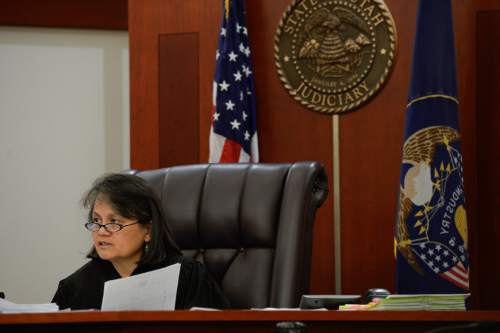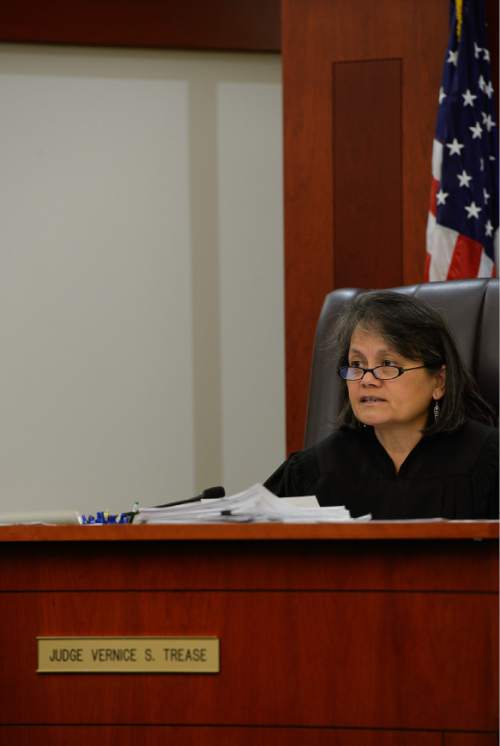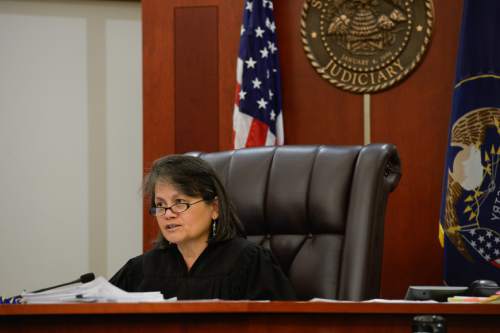This is an archived article that was published on sltrib.com in 2016, and information in the article may be outdated. It is provided only for personal research purposes and may not be reprinted.
Reyes Aguilar flew to New Mexico this past week to attend a recruitment seminar for American Indian students interested in the law.
It's part of a long-term vision, a decades-long effort that Aguilar, as associate dean for admissions at the University of Utah's law school, has led to try to make the Beehive State's legal community, traditionally dominated by white male lawyers, more diverse and, in the process, take the initial steps toward diversifying Utah's judicial bench — labeled in a recent study as the whitest in the nation and least reflective of the community it serves.
"It's not wrong to consider what a person's background and context and life experience is, because all that comes into play in the decision-making power [of the judiciary]," Aguilar said. "One of my frustrations has been … what I see as a presumption that, by somehow considering these things, a person is less qualified. And that creates a constant uphill battle for some of these very successful attorneys and very successful students."
Of the 102 judges in Utah's state courts, nearly seven out of every 10 are white males. A quarter are white female. Just 10 are ethnic minorities. There still has been only one African-American judge appointed to Utah courts in the state's history.
When it comes to nominating judges to the bench, Gov. Gary Herbert said his policy is "always to appoint the best, most qualified candidate for the position."
"That principle has led to a judiciary that has been recognized as one of the best in the country," he said, "and of which I am very proud."
Even so, his staff works with the Utah State Bar and other groups to try to diversify the pool of applicants from which the nominating commissions — and subsequently the governor — have to choose.
But efforts to diversify the courts have run into resistance from some lawmakers.
State Rep. Merrill Nelson, R-Grantsville, has been trying in the past several years to force the commissions that screen potential judges to disregard race and gender in the vetting process.
He specifically has sought to remove language from the judicial application that allows nominating panels, if all other factors are equal, to consider the issue of diversity on the bench.
Nelson contends the Utah Constitution and state law prohibit such considerations, and that there was never a public process to adopt such language.
In 2014, Nelson tried to withhold funding from the nominating commissions unless the language was dropped. His effort failed.
Earlier this year, after raising the issue in a legislative committee, Ron Gordon, executive director on the Commission of Criminal and Juvenile Justice, which staffs the nominating commissions, said the language would be removed.
"The law could not be more clear, from the [Utah] Constitution down to the statutes and even the regulations ... that appointments to the judiciary should be based solely on qualifications," Nelson said. "It's CCJJ that is not following the law, and I can't pass another law saying, 'Follow the law.' I have to leave that up to their integrity, and if they don't follow the law, then we have some remedies in the Legislature."
Instead of withdrawing the language, however, CCJJ proposed a new rule earlier this month that would formally adopt the diversity language that, heretofore, had been informally included.
"You have to have other factors to analyze when it appears that all applicants are comparable," Gordon said. "In those situations it is appropriate to consider the makeup of the bench and, as the administrative rule would say, the experience and background of the individuals who are applying."
—
The case for diversity • The American Constitution Society for Law and Policy recently looked at the makeup of state courts across the country and found a broad disparity between the racial and gender composition of the judiciary and the populations of those states.
Nowhere was the discrepancy more pronounced than Utah — although the report relied on 18-month-old data that skewed the numbers slightly.
"When people do not see themselves represented in their community leadership, when the vast majority of judges cannot relate to the lived experience of those they serve — this is a problem," said Tracey George, a law professor at Vanderbilt University and one of the report's co-authors.
Kate Berry, counsel at the Brennan Center for Justice at New York University, said three reasons generally argue for a diverse judiciary. A pool of judges from a broad background is "inevitably going to produce a richer experience" on the courts, she said. When the faces on the bench look like the community, "it looks to the public that the judicial system is fair and all voices are included."
Finally, women and minority judges can serve as role models to other attorneys, showing a career on the bench is achievable.
Last month, Berry wrote a report on ways nominating commissions could help ensure more women and minorities are considered for the bench. She said commissions and those who appoint judges need to be aware of biases in the process. More outreach can be done to encourage a wide range of applicants. And the process needs more transparency, so applicants know about openings and how the selection will work.
Kent Hart, executive director of the Utah Association of Criminal Defense Lawyers, doesn't believe there is "a lot of outright racial bias in Utah," but notes a pervasive sense that the decisions from the bench are made from a white, male perspective. His minority clients have mentioned it.
"There are reservations that a defendant facing a white, male judge or a bunch of jurors who are white, obviously it's going to reduce that person's confidence in the legal system," Hart said. "And if everyone is the same color or same gender, I think that's true, as well."
Nelson, who is an attorney and was a finalist for a judgeship during Gov. Mike Leavitt's tenure, doesn't buy the traditional arguments for diversity.
"What a litigant can expect is that judges will be entirely impartial, entirely fair and equal to everyone who comes to court, regardless of race or gender or so-called life experience," Nelson said. "When we start basing judicial office on factors or considerations other than legal ability, we get into a deep slippery slope where anything goes, and then we're no longer ensured we have the best quality [judges]."
—
Recruiting future lawyers, judges • The Utah Constitution deems that judges must be lawyers and members of the state bar. Utah's bar is overwhelmingly made up of white men.
According to the bar's most recent demographic survey of its members in 2011, 74 percent of Utah's lawyers are men and 91 percent are white — virtually the same racial and gender breakdown as those judges now on the bench.
"We take some of the responsibility at the law-school level," said Robert Adler, dean of the U. law school. Graduates of the U. and Brigham Young University law schools comprise 43 of the 65 judges nominated in the past five years.
"It starts at the bottom," Adler said, "trying to increase the pool of minority attorneys in Utah, which we've been working quite hard to do."
That's where Aguilar's efforts come into play — not just in the interest of the judiciary, but in improving diversity in the legal community and in helping convince minorities that a college degree and law school can be a reality.
The U.'s work starts in elementary schools, where law students and others work with the Kids' Court program at Rose Park Elementary on Salt Lake City's west side, working to teach diverse groups of students in the after-school program about the importance of the rule of law and civic engagement. Students also visit the law school and hold a mock trial.
Later, mostly high school seniors attend a one-day program at the law school to learn about the law and what it is like to be a law student.
The U. also is doing outreach to minority students who have shown an interest in the law. On Thursday, for example, Aguilar was in Albuquerque, where he will meet with American Indian students who participated in an eight-week summer program and offer admission to some top performers.
It's a slow, forward-looking effort, to be sure. But Aguilar points to numerous success stories among the students who have come through the law school in the 25 years he has run the programs. He said the experiences those students and other minorities have had is worthy of consideration when choosing judges.
—
Herbert's record • Statistics show that, at least with gender, Utah's judiciary may be inching toward greater diversity.
An analysis of Herbert's judicial nominees since he became governor in August 2009 reveals that 21 of his 65 picks, about a third, have been women. (The Utah Senate rejected one of those female nominees.)
The rate at which Herbert chooses women to fill judicial vacancies is about on par with the number who are recommended to him by nominating commissions, which vet candidates and send, on average, five names from which the governor selects.
In the past five years, the nominating panels have forwarded 204 candidates for judicial openings; 69 of them have been women, slightly more than a third.
Herbert has appointed fewer ethnic minorities to the bench — five of the 65 nominees during his tenure have self-identified as racial or ethnic minorities: Judges Su Chon, Renee Jimenez, Tupakk A.G. Renteria and Sharon Sipes, along with Supreme Court Justice Deno Himonas.
That representation (7.7 percent) is slightly below the current minority representation on Utah's bench and the minority makeup of the state bar.
"To increase the diversity of the bench," Herbert said, "we must also increase the diversity of the bar and the applicants who apply for judicial positions."
As a veteran of more than 60 nominating commissions, Gordon said he is "very much aware of the makeup of our bench. I'm not surprised [by the numbers] but that doesn't mean I'm not disappointed and wish we could find [more applicants]."
He said the Utah Minority Bar Association and Women Lawyers of Utah have reached out to ensure a wide pool of applicants.
"I don't think [diversity] just happens on its own," Gordon said. "I think we have to be proactive in some ways to make sure we have a quality bench in all respects and, two, to make sure we have a bench that has some diversity of background and experience."
gehrke@sltrib.com Twitter: @RobertGehrke











